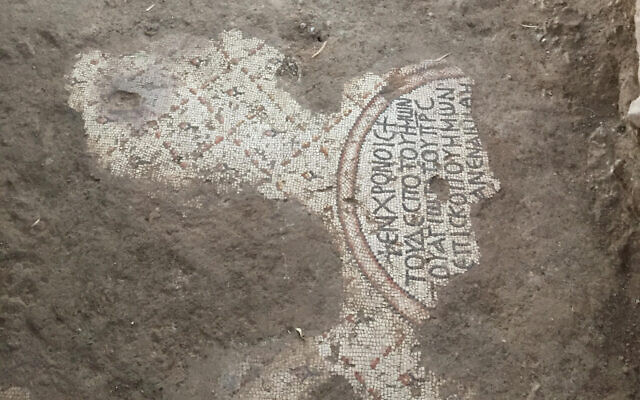An inscription found at an excavation near the Sea of Galilee strengthens beliefs that the site was a church built over the home of Saint Peter and his brother Andrew, two of the first disciples of Jesus, archaeologists said.
Researchers believe the building is the lost Byzantine period Church of the Apostles located in the biblical village of Bethsaida.
Archeologists from the Kinneret Institute for Galilee Archeology at Kinneret College and Nyack College, led by Prof. Mordechai Aviam and Prof. Steven Notley, said Wednesday that the inscription in a mosaic floor uses a common term for Peter, strengthening their theory that they have correctly identified the location.
It begins with the donor’s name, “Constantinos the Servant of the Messiah,” and then uses a Byzantine phrase, the “Head and Leader of the Heavenly Messengers,” that refers to Peter, the first disciple of Jesus.
The partial text was translated by Prof. Leah Di Segni from the Hebrew University and Prof. Jacob Ashkenazi from Kinneret College.
Get The Times of Israel's Daily Edition by email and never miss our top stories
The discovery “clearly indicates that the church was dedicated” to Peter, the researchers said in the statement.
“Byzantine Christian tradition routinely identified the house of Peter and Andrew as in Bethsaida. It is likely that the basilica commemorates their house,” explained Notley, the academic director of the excavation.

The mosaic floor of the Church of the Apostles, near the Sea of Galilee. (Mordechai Aviam/Courtesy)
“This discovery also reinforces its identification with a church described by Willibald, the bishop of 8th-century Eichstadt, who reported that it was built over the house of Peter and Andrew,” Notley said.
Willibald traveled in 724 CE on pilgrimage to holy sites along the northern shore of the Sea of Galilee, and was recorded saying: “And thence they went to Bethsaida, the residence of Peter and Andrew, where there is now a church on the site of their house. They remained there that night, and the next morning went to Chorazin, where our Lord healed the demoniacs, and sent the devil into a herd of swine.”
The inscription, framed by a circular medallion made of two lines of black stones, forms part of a larger mosaic floor in the church’s diaconicon room. It is partly decorated with floral and geometric patterns.
Archaeologists had announced discovery of the purported church building in 2019, and have been working at the site since then. Last year they uncovered the mosaic floor. The building — approximately 27 by 16 meters (88 by 52 feet) in size, covered with the colorful mosaic — is a suitable candidate for the lost church, archaeologists said at the time.
Researchers hope they will find another inscription referring to Peter’s brother, Andrew, which would further add to evidence that the site is that of the brothers’ home.
Dror Ben-Yosef, head of heritage in the Northern District of the Nature and Parks Authority, said in the statement the inscription “opens a window to identify the site with the Roman and Byzantine Bethsaida, a place cursed by Jesus because its inhabitants did not accept his gospel.”
He said the discovery may prompt Christian tourism to the site, as believers are drawn to sites where history related to Jesus is found.
Excavations are to continue in October with the aim of cleaning the entire church and the hope of finding more inscriptions.
The project, which recently completed its sixth excavation at the site, is sponsored by the Center for the Study of Ancient Judaism and Christian Sources, the Museum of the Bible in Washington, the Lanier Theological Library Foundation and the Hadavar Yeshiva.


